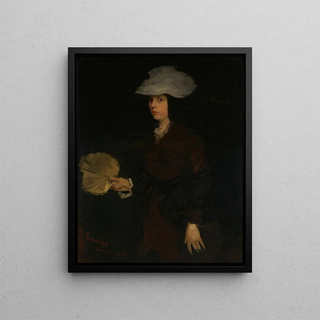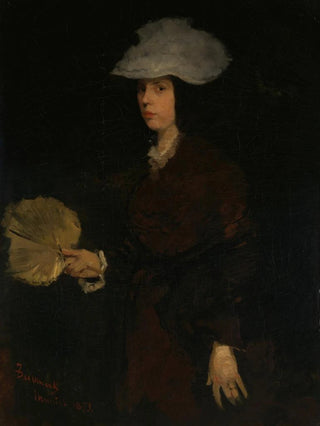Art print Dame à l'éventail - Frank Duveneck | Art print Source: Tableau Dame à l'éventail - Frank Duveneck | Reproduction


View from behind

Frame (optional)
Art print Dame à l'éventail - Frank Duveneck – Engaging introduction
The canvas "Dame à l'éventail" by Frank Duveneck is a work that evokes not only the beauty of a woman but also the very essence of urban life at the end of the 19th century. This painting, imbued with delicacy and sophistication, transports us into a universe where elegance blends with the simplicity of everyday gestures. The woman depicted, dressed in an elegant gown, holds a fan that seems both a fashion accessory and a symbol of mystery. Through this work, Duveneck manages to capture a fleeting moment, a pause amid the tumult of life, inviting the viewer to contemplate the ephemeral beauty of the moment.
Style and uniqueness of the work
Duveneck's style is distinguished by its realistic approach and its ability to infuse deep humanity into his portraits. In "Dame à l'éventail," the technique of light and shadow is masterfully executed, creating an intimate atmosphere. The delicate nuances of the woman's skin contrast with the richness of her dress's colors, while the fan adds a touch of dynamism to the composition. This canvas perfectly illustrates the transition between realism and impressionism, where each brushstroke seems to capture not only the form but also the soul of the model. The woman, although frozen in time, exudes an impression of liveliness, as if she might at any moment turn toward the viewer and confide her secret thoughts.
The artist and his influence
Frank Duveneck, an emblematic figure of 19th-century American art, knew how to establish himself thanks to his exceptional talent and innovative approach. Trained at the Kunstakademie in Munich, he was influenced by the great European masters while developing a style unique to himself. His work demonstrates a profound understanding of light and colors, as well as a singular sensitivity to human nature. Duveneck also played a key role in shaping the artistic scene in Cincinnati, where he trained many artists and contributed to the emergence of a local artistic movement. His ability to capture

Matte finish

View from behind

Frame (optional)
Art print Dame à l'éventail - Frank Duveneck – Engaging introduction
The canvas "Dame à l'éventail" by Frank Duveneck is a work that evokes not only the beauty of a woman but also the very essence of urban life at the end of the 19th century. This painting, imbued with delicacy and sophistication, transports us into a universe where elegance blends with the simplicity of everyday gestures. The woman depicted, dressed in an elegant gown, holds a fan that seems both a fashion accessory and a symbol of mystery. Through this work, Duveneck manages to capture a fleeting moment, a pause amid the tumult of life, inviting the viewer to contemplate the ephemeral beauty of the moment.
Style and uniqueness of the work
Duveneck's style is distinguished by its realistic approach and its ability to infuse deep humanity into his portraits. In "Dame à l'éventail," the technique of light and shadow is masterfully executed, creating an intimate atmosphere. The delicate nuances of the woman's skin contrast with the richness of her dress's colors, while the fan adds a touch of dynamism to the composition. This canvas perfectly illustrates the transition between realism and impressionism, where each brushstroke seems to capture not only the form but also the soul of the model. The woman, although frozen in time, exudes an impression of liveliness, as if she might at any moment turn toward the viewer and confide her secret thoughts.
The artist and his influence
Frank Duveneck, an emblematic figure of 19th-century American art, knew how to establish himself thanks to his exceptional talent and innovative approach. Trained at the Kunstakademie in Munich, he was influenced by the great European masters while developing a style unique to himself. His work demonstrates a profound understanding of light and colors, as well as a singular sensitivity to human nature. Duveneck also played a key role in shaping the artistic scene in Cincinnati, where he trained many artists and contributed to the emergence of a local artistic movement. His ability to capture
12,34 €






